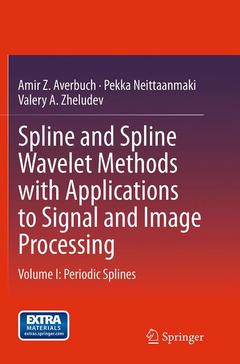Description
Spline and Spline Wavelet Methods with Applications to Signal and Image Processing, 2014
Volume I: Periodic Splines
Authors: Averbuch Amir Z., Neittaanmaki Pekka, Zheludev Valery A.
Language: English
Subjects for Spline and Spline Wavelet Methods with Applications to...:
Approximative price 116.04 €
In Print (Delivery period: 15 days).
Add to cartPublication date: 09-2016
Support: Print on demand
158.24 €
In Print (Delivery period: 15 days).
Add to cartPublication date: 04-2014
496 p. · 15.5x23.5 cm · Hardback
Description
/li>Contents
/li>Biography
/li>Comment
/li>
This volume provides universal methodologies accompanied by Matlab software to manipulate numerous signal and image processing applications. It is done with discrete and polynomial periodic splines. Various contributions of splines to signal and image processing from a unified perspective are presented. This presentation is based on Zak transform and on Spline Harmonic Analysis (SHA) methodology. SHA combines approximation capabilities of splines with the computational efficiency of the Fast Fourier transform. SHA reduces the design of different spline types such as splines, spline wavelets (SW), wavelet frames (SWF) and wavelet packets (SWP) and their manipulations by simple operations. Digital filters, produced by wavelets design process, give birth to subdivision schemes. Subdivision schemes enable to perform fast explicit computation of splines' values at dyadic and triadic rational points. This is used for signals and images up sampling. In addition to the design of a diverse library of splines, SW, SWP and SWF, this book describes their applications to practical problems. The applications include up sampling, image denoising, recovery from blurred images, hydro-acoustic target detection, to name a few. The SWF are utilized for image restoration that was degraded by noise, blurring and loss of significant number of pixels. The book is accompanied by Matlab based software that demonstrates and implements all the presented algorithms. The book combines extensive theoretical exposure with detailed description of algorithms, applications and software.
The Matlab software can be downloaded from http://extras.springer.com
1 Introduction: Signals and transforms.- 2 Introduction: Periodic filters and filter banks.- 3 Mixed circular convolutions and Zak transforms.- 4 Periodic polynomial splines.- 5 Polynomial smoothing splines.- 6 Calculation of splines values by subdivision.- 7 Spline algorithms for deconvolution and inversion of heat equation.- 8 Periodic spline wavelets and wavelet packets.- 9 Discrete-time periodic wavelet packets.- 10 Deconvolution by regularized matching pursuit.- 11 Block-based inversion of the heat equations.- 12 Hydro-acoustic target detection.- 13 Periodic discrete splines.- 14 Discrete periodic spline wavelets and wavelet Packets.- 15 Biorthogonal wavelet transforms.- 16 Biorthogonal wavelet transforms originating from splines.- 17 Wavelet frames generated by spline based p-filter banks.- 18 Application of periodic frames to image restoration.- Appendix: Guide to SplineSoftP.- Glossary.- Index.
Amir Averbuch is a professor of Computer since 1987 in the School of Computer Science, Tel Aviv University. He is also the founder and CSO of ThetaRay LTD. He got his B.Sc and M.Sc in mathematics from the Hebrew University in Jerusalem in 1968, 1975, respectively, and a PhD in computer Science from Columbia University in 1983. He has over 30 years of experience in research and development in academia and industry. Between 1977-1986 he was research staff member in IBM T.J. Watson Research Center, Yorktown Heights. New York. His research interests include applied and computational harmonic analysis, big data processing and analysis, cyber security, signal/image processing, Wavelets, scientific computing He was visiting professor in many places. He has supervised 102 M.Sc. 19 PhD and 13 post-doc students. He has published 198 papers in refereed journals, 170 papers in conferences, 10 chapters in books and 20 patents.
Pekka Neittaanmäki is Professor in Scientific Computing and Dean of the Faculty of Information Technology and Head of COMAS (Computing and Mathematical Sciences) Graduate School at the University of Jyväskylä, Visiting Professor at the Tokyo Institute of Technology, Japan, and Adjoint Professor at the University of Houston, USA. His research interests are mathematical and numerical modeling, signal analysis, data analysis, optimization and optimal control. He is the author or co-author of more than 300 publications in various parts of nume
rical analysis and applied mathematics including 14 books. He has supervised more than 80 PhD theses. He has participated in many industrial projects in Finland and Europe including among others paper machine, telecommunication, process industry as well as medical diagnostics applications.Valery A. Zheludev, received his M.S. degree on Math. Physics from St. Petersburg State University, Russia. He received Ph.D. degree on Math. Physics from Steklov Math. Inst. of Acad. Sci.

